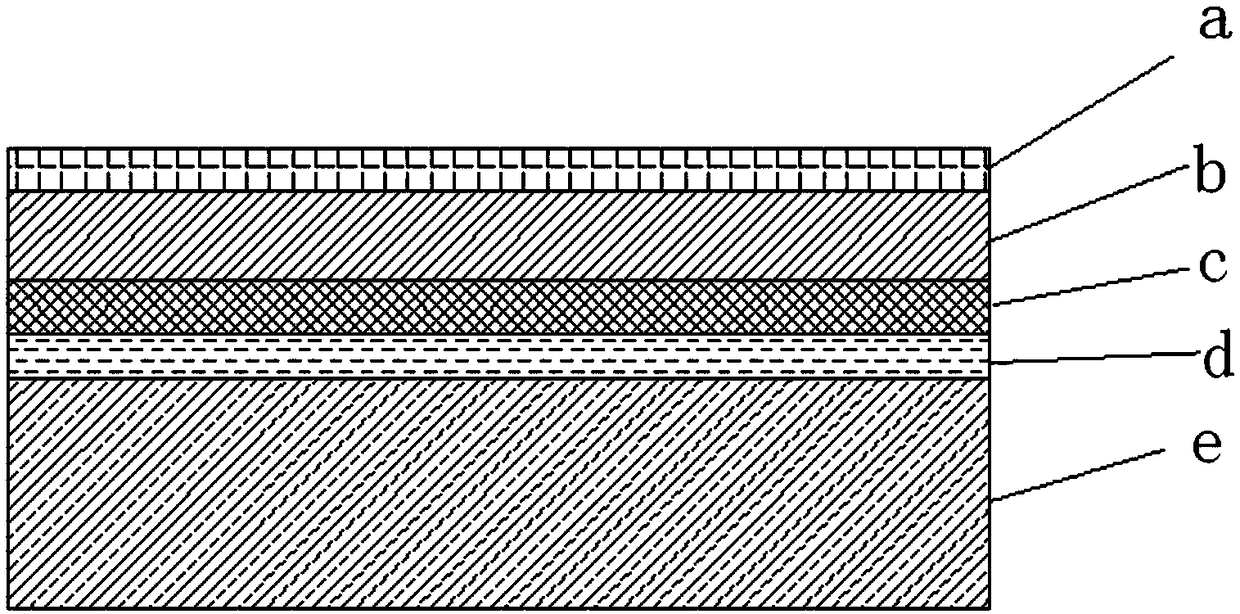Preparation method of multi-layer composite high-temperature corrosion-resistant coating based on high-temperature nickel-based alloy
A high-temperature corrosion-resistant, nickel-based alloy technology, applied in metal material coating process, coating, superimposed layer plating and other directions, can solve problems such as low operating temperature, salt spray corrosion, coating failure, etc. The effect of enhanced shock resistance, high oxidation resistance and long service life
- Summary
- Abstract
- Description
- Claims
- Application Information
AI Technical Summary
Problems solved by technology
Method used
Image
Examples
Embodiment 1
[0027] Polish the surface of the nickel-based alloy with 200-mesh and 600-mesh sandpaper, and ultrasonicate it in acetone for 5 minutes to remove the grinding powder and residual organic matter on the surface. The surface of the substrate is ion-cleaned for 5 minutes, and the Al-Si transition layer is sputtered at room temperature for 20 minutes. After sputtering, it is annealed in vacuum at 850°C for 30 minutes, then moved back to the magnetron sputtering chamber, and Ti is sputtered at 300°C. 3 Si(Al)C 2 Connection layer, sputtered surface power density 30W / cm 2 , sputtering time 1.5h. After the sputtering is completed, the substrate is put into the arc ion plating equipment, and the Ar-N 2 The aluminum-rich Al-Ti-Cr-Si-N gradient layer was synthesized by arc reaction at 400°C in the atmosphere, the negative bias voltage was controlled at 350V, and the arc currents of Ti-Al, Al-Si, and Cr were controlled at 80A, 60A, 30A, reaction time 4h. After plating the gradient laye...
Embodiment 2
[0029]The nickel-based alloy substrate was polished with 200 mesh, 400 mesh and 800 mesh sandpaper, ultrasonicated in acetone for 3 minutes, dried for 10 minutes, and the surface was ion cleaned for 5 minutes, and the Al-Si transition layer was sputtered at room temperature for 15 minutes. After sputtering, anneal in vacuum at 900°C for 30min, move back to the magnetron sputtering chamber, and sputter Ti at 400°C 3 Si(Al)C 2 Connection layer, sputtering surface power density 25W / cm 2 , sputtering time 1h. After the sputtering is completed, the substrate is put into the arc ion plating equipment, and the aluminum-rich Al-Ti-Cr-Si-N gradient layer is synthesized by the arc reaction at 300°C. The negative bias voltage is controlled at 450V, and Ti-Al, Al-Si, Cr The arc current is controlled at 60A, 60A, 40A, and the reaction time is 6h. After the gradient layer is plated, move back to the magnetron sputtering chamber, 450 ℃ high temperature radio frequency sputtering Si 3 N ...
Embodiment 3
[0031] The nickel-based alloy substrate was polished with 200 mesh, 600 mesh and 1200 mesh sandpaper, ultrasonicated in acetone for 5 minutes, dried for 5 minutes, and the surface was ion cleaned for 5 minutes, and the Al-Si transition layer was sputtered at room temperature for 30 minutes. After sputtering, vacuum anneal at 1000°C for 30 minutes, move back to the magnetron sputtering chamber, and sputter Ti at 350°C 3 Si(Al)C 2 Connection layer, sputtering surface power density 45W / cm 2 , sputtering time 2h. After the sputtering is completed, the substrate is put into the arc ion plating equipment, and the aluminum-rich Al-Ti-Cr-Si-N gradient layer is synthesized by the arc reaction at 400°C. The negative bias voltage is controlled at 600V, and Ti-Al, Al-Si, Cr The arc current is controlled at 50A, 80A, 40A, and the response time is 4.5h. After the gradient layer is plated, move back to the magnetron sputtering chamber, 500 ℃ high temperature radio frequency sputtering Si ...
PUM
| Property | Measurement | Unit |
|---|---|---|
| purity | aaaaa | aaaaa |
Abstract
Description
Claims
Application Information
 Login to View More
Login to View More - R&D
- Intellectual Property
- Life Sciences
- Materials
- Tech Scout
- Unparalleled Data Quality
- Higher Quality Content
- 60% Fewer Hallucinations
Browse by: Latest US Patents, China's latest patents, Technical Efficacy Thesaurus, Application Domain, Technology Topic, Popular Technical Reports.
© 2025 PatSnap. All rights reserved.Legal|Privacy policy|Modern Slavery Act Transparency Statement|Sitemap|About US| Contact US: help@patsnap.com

